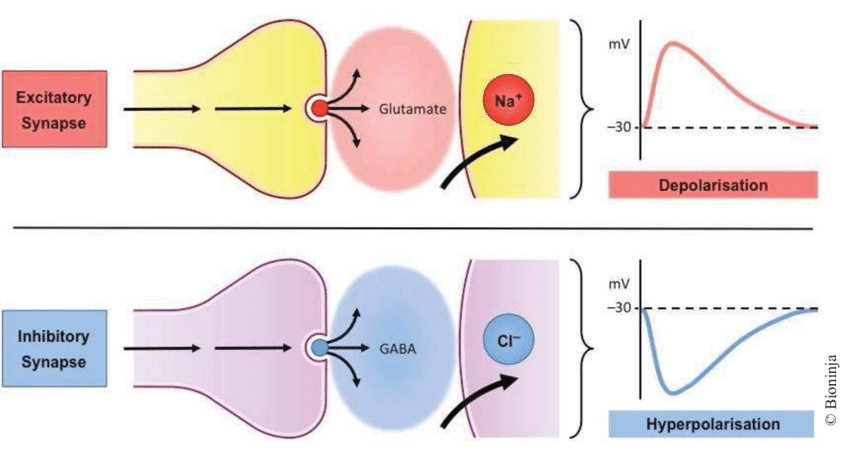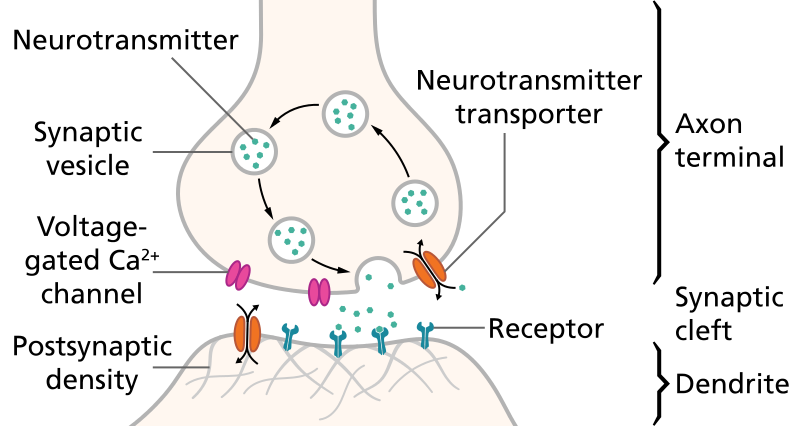Neurons, the fundamental cells of the nervous system, rely on a complex interplay of chemical signals called neurotransmitters to communicate with each other. Synapses, microscopic junctions between neurons, are the stage where this intricate chemical symphony unfolds. This article explores how neurotransmitters are released from presynaptic neurons, bind to receptors on postsynaptic neurons, and ultimately influence electrical activity.
Diverse Messengers: The Major Players
Several types of neurotransmitters exist, each with distinct effects on neuronal communication:
- Excitatory neurotransmitters: These increase the electrical activity (firing) of the postsynaptic neuron. Examples include glutamate, the most abundant neurotransmitter in the brain, and acetylcholine, involved in muscle movement and memory.
- Inhibitory neurotransmitters: These decrease the electrical activity of the postsynaptic neuron. Gamma-aminobutyric acid (GABA) is the main inhibitory neurotransmitter, responsible for calming neuronal activity. Glycine also plays an inhibitory role, particularly in the spinal cord.
- Modulatory neurotransmitters: These neurotransmitters have more subtle effects, influencing mood, reward, and arousal. Dopamine, serotonin, and norepinephrine are examples of modulatory neurotransmitters.
The specific neurotransmitter used at a synapse determines whether the signal transmitted is excitatory or inhibitory, ultimately affecting various physiological and behavioral processes.
The Dance of Neurotransmitters: Release, Binding, and Action
The neurotransmitter journey begins with its synthesis within the presynaptic neuron. When an electrical signal (action potential) arrives at the presynaptic terminal, it triggers the release of neurotransmitters from storage vesicles into the synaptic cleft, the small gap between neurons. Calcium ions entering the presynaptic terminal through voltage-gated channels mediate this release process.
Neurotransmitters then diffuse across the synaptic cleft and bind to specific receptor proteins on the postsynaptic membrane. This binding initiates a cascade of events within the postsynaptic neuron. Excitatory neurotransmitters often lead to the opening of ion channels, allowing positively charged ions (like sodium) to enter the cell. This influx of ions depolarizes the membrane, making it more likely for the postsynaptic neuron to fire an action potential. Conversely, inhibitory neurotransmitters cause the opening of chloride channels or block excitatory channels. This leads to hyperpolarization of the membrane, making it less likely for the postsynaptic neuron to fire an action potential.
Clearing the Stage: Neurotransmitter Removal
For efficient and precise communication, neurotransmitter action must be temporary. There are two main mechanisms for terminating the signal:
- Enzymatic degradation: Enzymes located in the synaptic cleft or within glial cells surrounding the synapse break down specific neurotransmitters. Acetylcholinesterase is an example of an enzyme that degrades acetylcholine.
- Reuptake: Neurotransmitters are actively transported back into the presynaptic neuron for recycling. This process is crucial for regulating synaptic strength and preventing prolonged activation.
Understanding Neurotransmitters: Key to Brain Function
Neurotransmitter function is essential for understanding how the nervous system works. Disruptions in neurotransmitter systems are implicated in various neurological and psychiatric disorders. For instance, reduced dopamine signaling is associated with Parkinson's disease, while imbalances in serotonin and norepinephrine can contribute to depression and anxiety.
Ongoing research into neurotransmitters continues to shed light on their complexities, paving the way for new therapies targeting these systems. The intricate interaction between neurotransmitters and their receptors remains a fascinating area of scientific exploration, helping us understand how our brains control thought, movement, and behavior.
Neurotransmitter Research: A Quest for Precision
Neurotransmitter research is a dynamic field that relies on high-purity reagents to ensure accurate and reliable results. Reputable suppliers, like Maxanim, provide researchers with the essential tools to study these critical molecules.
Learn more in this video:


Neurotransmitters: Orchestrating Communication Between Neurons